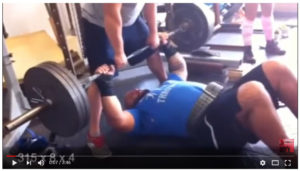If you have done any reading about precision point training, you will probably notice that I often mention the importance of maintaining a steady even rep pace. Why is this important? Because as long as you can maintain a steady even rep pace, the creatine phosphate system within your muscles is acting as the dominant energy fuel provider for muscle contractions. This is desirable because the creatine phosphate system is the most powerful energy system for enabling powerful muscle contraction. In contrast, when you can no longer maintain a steady even rep pace due to fatigue, the lactate system is taking over as the dominant fuel provider for muscle contractions. The lactate system is inferior to the creatine phosphate system in terms of providing quality fuel for powerful muscle contractions. If your goal is to gain strength, you should focus on creating conditions that cause the creatine phosphate system to increase its capacity, not the lactate system. This is done by repeating reps only as long as you can maintain a steady even rep pace.
The Problem With a Steady Rep Pace
The only problem with using a steady even rep pace as a gauge for when to stop a set is that some lifters make no effort to maintain a steady even rep pace when they lift. Lifters who do this have no bases for determining their capacity for repeating reps while in the creatine phosphate system. This means that one of the prerequisites to being able to use precision point training in an effective manner is to learn to use a steady even rep pace for as long as possible when performing a set.
If you watch the following video, you will see two lifters. The first is performing floor presses using a steady even rep pace. He stops when he reaches his limit of being able to repeat reps at a steady rep pace. The rep pace of the second lifter is a little less consistent. This will make it more difficult for him to determine when he has reached the capacity of his creatine phosphate energy system.
There are many bodybuilders and powerlifters who use an even lifting rhythm as long as possible when performing a set, however, I need to make a clarification; maintaining a steady even rep pace does not mean that a lifter is not allowed to pause at the top or bottom of a rep. You may see lifters who always pause at the top or bottom of a rep, but they always pause the same amount of time and use the same rep speed and lifting rhythm for each rep. In this case, they are repeating reps at the same pace. Some lifters also tend to prefer slower reps while others prefer fast reps, but if they are using a steady even rep pace, they will do each rep the same way within a set. This is true of both Dorian Yates and Arnold Schwarzenegger as you can see if you watch the next two videos. Dorian Yates prefers slower reps with a pause in the contracted position, and Arnold Schwarzenegger does his reps a little faster without pausing at the top or bottom, but both are consistent in terms of the speed and manner in which they repeat their reps.
Dorian Yates: Former Mr. Olympia
Arnold Schwarzenegger: Perhaps The Most Famous Bodybuilder Ever
When a lifter pushes to failure but they do so by maintaining a steady even rep pace as long as possible, it is easy to identify the point in the set where rep speed starts to slow down. In the following video, Arnold maintains a steady even rep pace for nine reps when doing the bench press. He then slows down on his last three reps. Obviously, Arnold thrived on high intensity training and pushing to failure, however, if you do not respond as well as Arnold did to pushing sets to failure, you would want to stop when your rep pace starts to slow down.
Arnold: 9 Even Paced Reps followed by 3 Slower Reps
By this point in the article, hopefully you will conclude that it helps to be aware of whether or not you are using a steady even rep pace as long as possible when you perform a set. If you find that you are not using a steady lifting rhythm, it would be beneficial to start doing so because it will help you to identify your capacity to repeat reps while in the creatine phosphate system. This will help you to train more effectively. Best of training to you!

